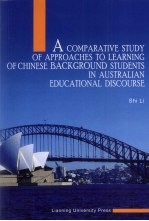

澳洲大学中文背影学生学习方法之比较研究PDF电子书下载
- 电子书积分:12 积分如何计算积分?
- 作 者:李适编
- 出 版 社:沈阳:辽宁大学出版社
- 出版年份:2010
- ISBN:7561060186
- 页数:348 页
Chapter 1 Introduction 1
1.1 My reflective journey 1
1.2 Introduction 3
1.3 Background leading to this study 3
1.4 Aims and objectives of this study 9
1.5 Research questions 10
1.6 Research methodology 11
1.6.1 Method 15
1.6.2 Data collection and analysis 23
1.7 Ethical lssues 25
1.8 The significance of this study 28
1.9 Limitations of this study 31
1.10 The structure of the book 33
1.11 Conclusion 36
Chapter 2 Literature Review 38
2.1 Introduction 38
2.2 Background leading to literature review 39
2.3 Approaches to learning 41
2.4 Approaches to learning of Chinese background students 47
2.5 National identities of Chinese background students 56
2.6 Conclusion 57
Chapter 3 National Background 59
3.1 Introduction 59
3.2 Social-political and economical Backgrounds 61
3.2.1 Of mainland Chinese students 61
3.2.2 Of Hong Kong Chinese students 63
3.2.3 Of Chinese Singaporean students 65
3.2.4 Of Chinese Malaysian students 67
3.3 Educational background 70
3.3.1 Of mainland Chinese students 70
3.3.2 Of Chinese Hong Kong students 74
3.3.3 Of Chinese Singaporean students 76
3.3.4 Of Chinese Malaysian students 77
3 4 The Chinese culture 79
3.5 Discussion 86
Chapter 4 Methodology 91
4.1 Introduction 91
4.1.1 Background 91
4.1.2 Research aims and objectives 92
4.2 Research Design 93
4.3 Quantitative research 97
4.3.1 Questionnaire 98
4.3.2 Participants 104
4.3.3 Questionnaire data collection 105
4.3.4 Measure and procedures 106
4.4 Qualitative research 107
4.4.1 Interview and constructivist grounded theory 108
4.4.2 Critical analysis of Australian Government documentation 120
Chapter 5 Quantitative Analysis 122
5.1 Introduction 122
5.2 Quantitative research objectives 122
5.3 Data processing procedure 124
5.4 Data analysis 127
5.4.1 The backgrounds of participants 127
5.4.2 Comparing means of DVs with Ⅳ of Chinese background students 129
5.4.2.1 Analysis of Learning Strategies 130
5.4.2.1.1 Analysis of Memorisation Strategies 130
5.4.2.1.2 Analysis of Elaboration Strategies 136
5.4.2.1.3 Analysis of Organisation Strategies 137
5.4.2.1.4 Analysis of Affective Strategies 138
5.4.2.1.5 Analysis of Control Strategies 144
5.4.2.2 Analysis of Motivation 150
5.4.2.2.1 Analysis of Instrumental Motivation 150
5.4.2.2.2 Analysis of Interest in Reading 156
5.4.2.2.3 Analysis of Effort and Persistence in Learning 158
5.4.2.3 Analysis of Self-related Beliefs 163
5.4.2.3.1 Self-efficacy 163
5.4.2.3.2 Academic Self-concept 167
5.4.2.4 Learning Preferences 172
5.4.2.4.1 Preference for Co-operative Learning 172
5.4.2.4.2 Preference for Competitive Learning 179
5.4.2.5 Approaches to learning 185
5.4.3 Comparing means of DV with other Ⅳ 191
5.4.3.1 Gender 192
5.4.3.2 Academic faculty 194
5.4.3.3 Length of stay in Australia(up to now) 196
5.4.3.4 Undergraduate or postgraduate 198
5.4.3.5 English ability 200
5.5 General reflection 201
5.5.1 Approaches to learning 202
5.5.2 Other factors 208
5.6 Conclusion 209
Chapter 6 Thematic Analysis of Qualitative Data 212
6.1 Introduction 212
6.2 Qualitative research objectives 213
6.3 Framework of qualitative research 213
6.4 The interview process 216
6.5 Analysis of qualitative data outcomes 221
6.5.1 Approaches to learning 222
6.5.2 Linguistic,educational and social influences 241
6.5.3 National identities 253
6.6 Conclusion 265
Chapter 7 National Identities in Australian Government Documentation 268
7.1 Introduction 268
7 2 Background 269
7.3 General characterisation of financial proof for overseas student visa applicants 271
7.4 Theoretical framework 281
7.5 Data analysis 282
7.6 Responses from Chinese background students concerned 288
7.7 Discussion and conclusion 289
Chapter 8 Conclusion 292
8.1 Introduction 292
8.2 Conclusion about each research question 293
8.2.1 Findings in relation to approaches to learning 295
8.2.2 Findings in relation to linguistic,educational and sacial factors 298
8.2.3 Findings in relation to national identities 298
8.2.4 Findings in relation to the misconception of rote-learners 300
8.3 New knowledge and implication for practice 300
8.3.1 New knowledge to research 300
8.3.2 Implications for practice 302
8.4 Limitations and future research 305
References 308
Appendix 1:the Questionnaire of Approaches to Learning 331
Appendix 2:Key relevant Literature Reviewed on Culture,Identity,Approaches to Learning,and Learning Processes of Chinese Background Students Is Categorized Below for Reader-Friendly Purposes 339
- 《中风偏瘫 脑萎缩 痴呆 最新治疗原则与方法》孙作东著 2004
- 《断陷湖盆比较沉积学与油气储层》赵永胜等著 1996
- 《《国语》和《战国策》词汇比较研究》陈长书著 2017
- 《党员干部理论学习培训教材 理论热点问题党员干部学习辅导》(中国)胡磊 2018
- 《基于地质雷达信号波的土壤重金属污染探测方法研究》赵贵章 2019
- 《第一性原理方法及应用》李青坤著 2019
- 《数学物理方法与仿真 第3版》杨华军 2020
- 《Helmholtz方程的步进计算方法研究》李鹏著 2019
- 《跨文化交际背景下的中西文化比较研究》任永进,贺志涛著 2019
- 《深度学习与飞桨PaddlePaddle Fluid实战》于祥 2019
- 《初学棒针编织》王适编 2011
- 《面向人生 青少年交谊纪念册》钦少适编 1996
- 《红楼梦研究文选》郭豫适编 1988
- 《云》王志学,徐玉祥,刘天适编 1984
- 《国文成语辞典》壮适编 1925
- 《国文成语辞典》壮适编 1917
- 《百科用语分类大辞典》梁适编 1989
- 《扬弃与发展 弘扬民族优秀文化》郭豫适编 1993
- 《佛说·我说·你说》铁适编 1993
- 《中外名言分类大辞典》梁适编 1997
- 《大学计算机实验指导及习题解答》曹成志,宋长龙 2019
- 《大学生心理健康与人生发展》王琳责任编辑;(中国)肖宇 2019
- 《大学英语四级考试全真试题 标准模拟 四级》汪开虎主编 2012
- 《大学英语教学的跨文化交际视角研究与创新发展》许丽云,刘枫,尚利明著 2020
- 《复旦大学新闻学院教授学术丛书 新闻实务随想录》刘海贵 2019
- 《大学英语综合教程 1》王佃春,骆敏主编 2015
- 《大学物理简明教程 下 第2版》施卫主编 2020
- 《大学化学实验》李爱勤,侯学会主编 2016
- 《中国十大出版家》王震,贺越明著 1991
- 《近代民营出版机构的英语函授教育 以“商务、中华、开明”函授学校为个案 1915年-1946年版》丁伟 2017
